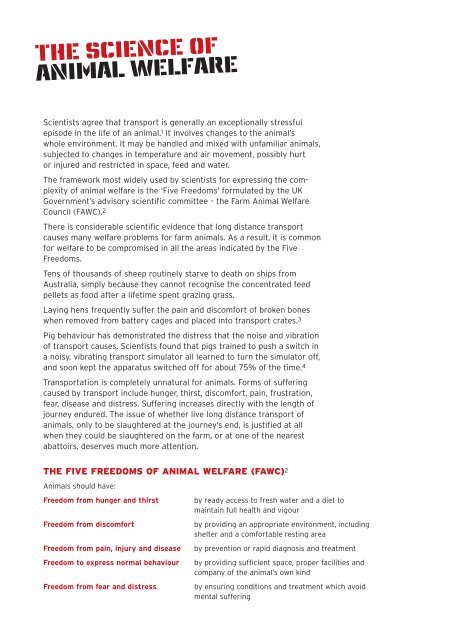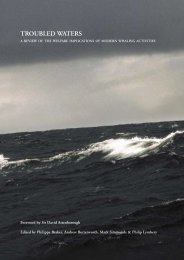Long Distance Transport and Welfare of Farm Animals
Long Distance Transport and Welfare of Farm Animals
Long Distance Transport and Welfare of Farm Animals
- No tags were found...
You also want an ePaper? Increase the reach of your titles
YUMPU automatically turns print PDFs into web optimized ePapers that Google loves.
WSPA HWC Report 4pp Cover:WSPA HWC Report 4pp Cover 31/1/08 12:06 Page 3THE SCIENCE OFANIMAL WELFAREScientists agree that transport is generally an exceptionally stressfulepisode in the life <strong>of</strong> an animal. 1 It involves changes to the animal’swhole environment. It may be h<strong>and</strong>led <strong>and</strong> mixed with unfamiliar animals,subjected to changes in temperature <strong>and</strong> air movement, possibly hurtor injured <strong>and</strong> restricted in space, feed <strong>and</strong> water.The framework most widely used by scientists for expressing the complexity<strong>of</strong> animal welfare is the ‘Five Freedoms’ formulated by the UKGovernment’s advisory scientific committee – the <strong>Farm</strong> Animal <strong>Welfare</strong>Council (FAWC). 2There is considerable scientific evidence that long distance transportcauses many welfare problems for farm animals. As a result, it is commonfor welfare to be compromised in all the areas indicated by the FiveFreedoms.Tens <strong>of</strong> thous<strong>and</strong>s <strong>of</strong> sheep routinely starve to death on ships fromAustralia, simply because they cannot recognise the concentrated feedpellets as food after a lifetime spent grazing grass.Laying hens frequently suffer the pain <strong>and</strong> discomfort <strong>of</strong> broken boneswhen removed from battery cages <strong>and</strong> placed into transport crates. 3Pig behaviour has demonstrated the distress that the noise <strong>and</strong> vibration<strong>of</strong> transport causes. Scientists found that pigs trained to push a switch ina noisy, vibrating transport simulator all learned to turn the simulator <strong>of</strong>f,<strong>and</strong> soon kept the apparatus switched <strong>of</strong>f for about 75% <strong>of</strong> the time. 4<strong>Transport</strong>ation is completely unnatural for animals. Forms <strong>of</strong> sufferingcaused by transport include hunger, thirst, discomfort, pain, frustration,fear, disease <strong>and</strong> distress. Suffering increases directly with the length <strong>of</strong>journey endured. The issue <strong>of</strong> whether live long distance transport <strong>of</strong>animals, only to be slaughtered at the journey’s end, is justified at allwhen they could be slaughtered on the farm, or at one <strong>of</strong> the nearestabattoirs, deserves much more attention.THE FIVE FREEDOMS OF ANIMAL WELFARE (FAWC) 2<strong>Animals</strong> should have:Freedom from hunger <strong>and</strong> thirstFreedom from discomfortFreedom from pain, injury <strong>and</strong> diseaseFreedom to express normal behaviourFreedom from fear <strong>and</strong> distressby ready access to fresh water <strong>and</strong> a diet tomaintain full health <strong>and</strong> vigourby providing an appropriate environment, includingshelter <strong>and</strong> a comfortable resting areaby prevention or rapid diagnosis <strong>and</strong> treatmentby providing sufficient space, proper facilities <strong>and</strong>company <strong>of</strong> the animal’s own kindby ensuring conditions <strong>and</strong> treatment which avoidmental suffering
















